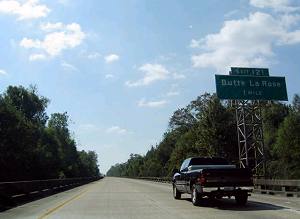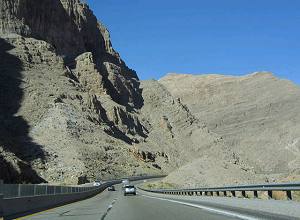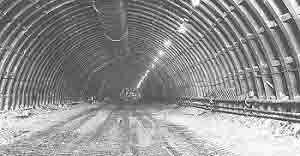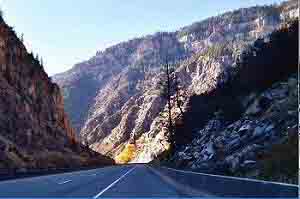INTERSTATE HIGHWAY SYSTEM
Interstate Highway System
A Historical Perspective on its Construction
The Dwight D. Eisenhower System of Interstate and Defense Highways was designated as one of the Seven Wonders of the United States in 1994 by the American Society of Civil Engineers (ASCE). To put this recognition into perspective one has only to look at other structures worthy of inclusion in the ASCE's list, including the Golden Gate Bridge, Panama Canal and the Hoover Dam.
The highway system is a marvel in construction. Not only does it link the nation from coast to coast, but it also helped to increase business productivity as companies are now able to get their goods anywhere in the United States more quickly and efficiently. In fact, since the highway system was started in 1956, our country has seen a tenfold increase in our gross national product, thanks to the construction companies who worked on this massive project.
No one construction company is responsible for the highway system; it was a task too monumental for any single company to undertake. For the most part, each state, with help from the federal government, was responsible for its own sections of the interstate highway system. Some states built their roads through their various transportation departments and some contracted out the job to highly skilled highway builders. The following describes just a few of the states where construction companies overcame huge challenges to help create the greatest highway system in the world.
Highway Construction in Louisiana
 One section of I-10 in Louisiana was earning design awards before it even opened in March of 1973. That stretch is the elevated roadway that runs across the Atchafalaya Swamp. The construction company responsible for this section of the interstate highway system is Boh Brothers Construction.
One section of I-10 in Louisiana was earning design awards before it even opened in March of 1973. That stretch is the elevated roadway that runs across the Atchafalaya Swamp. The construction company responsible for this section of the interstate highway system is Boh Brothers Construction.
The company was founded in 1909 when Arthur Boh built four duplexes in a small New Orleans neighborhood. When Arthur's brother Henry joined the company in 1913, they changed the name to Boh Brothers, a name it still carries today.
In the early part of the 20th Century they branched out from building construction and into drainage and sewage projects, growing modestly through the difficult times of the Depression. By this time the company started earning recognition for their expertise in underground work and pile-driving skills, eventually leading to them being considered the number one pile-driving contractor in the South.
As the company grew, it worked on war-related facilities, utilities, subdivisions, power plants and overpasses. Henry brought in some key employees who would later play a crucial role the interstate highway system project, including J.A. Tedford, D.E. Guiza, the company's first registered engineer, and B.C.Stewart. Stewart was a man so committed to providing quality workmanship that he was known for tearing out work if he didn't feel it was good enough - even if that work had already been approved by inspectors. Stewart became the company's vice president and senior consultant, positions he still holds today.
By the time the interstate highway system was ready to be built in Louisiana, Boh Bros. was ready for the task. The elevated section of highway across the Atchafalaya Swamp was constructed from precast segments. These segments were cast at a plant on Lake Pontchartrain, and then floated through a maze of streams and canals by barge to the Atchafalaya River Basin. When they arrived at the building site, the segments were then lifted by large cranes and placed on top of the supporting columns.
Highway Construction in Arizona
 A stretch of I-15 runs through the 500-year-old Virgin River Gorge in Arizona, an area that is known as a scenic wonder. When time came to build the interstate highway system through this area, the Kiewit Construction Company faced the challenge of building a highway system that was up to federal standards, yet did not ruin the beauty of the area.
A stretch of I-15 runs through the 500-year-old Virgin River Gorge in Arizona, an area that is known as a scenic wonder. When time came to build the interstate highway system through this area, the Kiewit Construction Company faced the challenge of building a highway system that was up to federal standards, yet did not ruin the beauty of the area.
Kiewit Construction Company started out as a local builder, as did many of the contractors who worked on the interstate highway system. After World War II, the company was forced to switch its focus to water projects because there was a great deal of that development going on in the western parts of the country. The company worked on many dams and canals, including the Friant-Kern Canal, which was designed to bring water to the Los Angeles area from Northern California; the Monticello Dam near Sacramento, a concrete arch dam that was built to feed water into the California Aqueduct; the concrete arch Flaming Gorge Dam on the Colorado River in Utah; and the earth-fill Garrison Dam on the Missouri River in North Dakota. When the United States and Canada began working together to develop the St. Lawrence Seaway in the mid-1950s, Kiewit contributed work on the Long Sault Canal and the Iroquois Dam.
Prior to the building of I-15, there was no road to take people through the beautiful scenery of the Gorge. The Federal Highway Administration wanted the highway to run through the Gorge because of its beauty, and thanks to its previous work on waterways Kiewit was up to the task. In order to build the highway, the Virgin River had to be re-channeled twelve different times and the road squeezed between the deep walls of the canyon.
The Virgin River Gorge section of the interstate highway system opened in 1973, and in 1988Arizona Highways Magazine stated that this section of the highway "enhanced rather than distracted from nature's handiwork." This is high praise indeed in an area whose citizens were rightfully protective of their region's natural splendor. So amazing was the job done by Kiewit Construction Company that this section of the interstate highway system has been deemed a wonder in itself.
To date, Kiewit has built more miles of the interstate highway system than any other construction company, including sections through Colorado's Glenwood Canyon, the Eisenhower Tunnel through the Colorado Rockies and the Ft. McHenry tunnel beneath Baltimore Harbor. Forbes Magazine called company president Peter Kiewit "The Colossus of Roads." Kiewit is still one of the largest transportation contactors in the United States today.
Highway Construction in Colorado
 The longest tunnel built as part of the interstate highway system is the Eisenhower Memorial Tunnel under the Continental Divide. Four construction companies joined together to form Straight Creek Constructors, a name derived from where the west portal of the tunnel was located. Members of this consortium were Al Johnson Construction Company of Minneapolis, Gibbons and Reed Company of Salt Lake City, Kemper Construction Company of Los Angeles and Western Paving Construction Company of Denver. The Division of Highways had estimated the cost of the project at $42.5 million, and the Straight Creek Constructors had the low bid at $54.1 million.
The longest tunnel built as part of the interstate highway system is the Eisenhower Memorial Tunnel under the Continental Divide. Four construction companies joined together to form Straight Creek Constructors, a name derived from where the west portal of the tunnel was located. Members of this consortium were Al Johnson Construction Company of Minneapolis, Gibbons and Reed Company of Salt Lake City, Kemper Construction Company of Los Angeles and Western Paving Construction Company of Denver. The Division of Highways had estimated the cost of the project at $42.5 million, and the Straight Creek Constructors had the low bid at $54.1 million.
The project called for completing the westbound tunnel; starting the eastbound tunnel a short distance into each end; constructing combination portal and ventilation buildings for all tunnel entrances; and installing such facilities as lighting, other utilities and an electronic surveillance system. The first bore was to open three years after beginning construction, and the second several years later.
Construction began on March 15, 1968. There were a number of challenges that had to be faced by the construction company.
Geologists had discovered that the bedrock in the tunnel was 75% granite and 25% gneiss and schist. In the pilot bore, more than 26% of the length was in self-supporting rock, with 74% needing support. There was also 820 feet of what tunnelers describe as bad rock-not the most ideal situation. Additional problems arose because the first bore was not in the same spot as the pilot bore, and so conditions were different from what contractors were expecting.
The workers had to excavate 524,000 cubic yards of rock at an elevation of eleven thousand feet, which made efficiency for both man and machine much lower than expected. That area of the country has a long winter season, making the available time for working on the outside of the tunnel very short. In order to get the work done on schedule, 1,140 people worked in three shifts, 24 hours a day, six days a week.
The greatest problem the construction company faced was the mountain itself. There was simply no way to predict how it would react to the great tunnels being bored through it, and it didn't always cooperate as contractors had planned. Stress would often show up, for example, where theory would indicate there should be none. In order to overcome these obstacles, the construction company had to devise new methodology, like creating a way to mine and support a hole 50 feet high and 45 feet wide.
All told, contractors used 190,000 cubic yards of concrete to line the tunnel, 34,000 cubic yards of concrete for the buildings, and 10,000 tons of steel reinforcing bars and 23,400 tons of structural steel in the tunnel.
On March 8, 1973, the first of the twin tunnels was dedicated and opened to traffic. The second bore was opened in December, 1979.
 Glenwood Canyon in Colorado, experts agree, was one of the most challenging sections of the interstate highway system, and another to which Kiewit Construction Company of Arizona lent its expertise. The canyon was formed by the Colorado River and includes 16 miles of steep, sheer cliffs on both sides of the river. Kiewit began work on the project in 1981, employing as many as 500 workers.
Glenwood Canyon in Colorado, experts agree, was one of the most challenging sections of the interstate highway system, and another to which Kiewit Construction Company of Arizona lent its expertise. The canyon was formed by the Colorado River and includes 16 miles of steep, sheer cliffs on both sides of the river. Kiewit began work on the project in 1981, employing as many as 500 workers.
Because this is an amazingly scenic area, environmentalists and other nature enthusiasts were concerned that the highway would mar the canyon's beauty. So afraid were environmentalists that Kiewit would ruin their lovely landscape that in 1984 the Colorado Open Space Council and Sierra Club joined forces to seek a restraining order to stop construction. Their motion was rejected, but contractors were required to disturb as little of the canyon as possible, even facing fines if their work harmed certain trees.
Kiewit had to find a way to make engineering and the environment work together, and they did it by introducing a construction method that had never before been used in the United States: balanced cantilever construction. This method enables construction companies to build bridges from above, rather than below. First a bridge column is built and then a gantry, a special type of crane, is positioned on top of the column. Using precast segments that were brought in by truck, the gantry was used to build the bridge outward from the column.
Construction on I-70 through Glenwood Canyon was completed in 1992, one full year ahead of schedule, at the cost of $490.3 million. All in all, more than 40 bridges and viaducts made of precast box girders, precast I-beams, cast-in-place post tension box girders and welded steel box girders were used to preserve as much of the canyon as possible.
